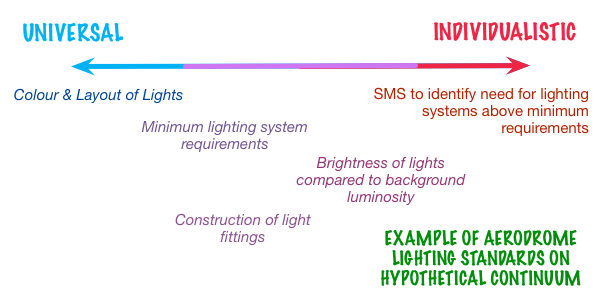Noun-based Regulation
The modern world is definitely in love with its noun-based activities. Each week, a paradigm-shifting approach to some human endeavour is announced with a title like value-based health care or outcome-based education. When I delve into the details, I am generally left either confused as to what they are selling or how they are different at all. Regulation is no different. Just plugging "based regulation" into Google yields, on the first page alone, principle-based, results-based, performance-based, outcomes-based and output-based regulatory approaches.
In aviation circles, the noun of choice appears to be performance but you still get a couple of hits on risk, outcome and objective. I must confess, however, that for all the reading I've done and the courses I've attended, I don't think I can concisely tell you what these system actually are or how their regulations are drafted.
I know that we need to move away from the purely prescriptive approach of the past. The aviation environment has gotten too complex for us to think we can regulate the how something is done in a manner which can consider all the variables.
The Australian airport industry is a great example of this. Not too long ago, all the airports in Australia were either owned or heavily directed by the federal government. They were also either major international airports, regional jet or turbo prop airports or other. Nowadays, airports are operated by a variety of public and private entities, we have rapidly expanding and brand new airports as well as stagnate and declining ports. The industry is dynamic, volatile and complex.
The Move from Prescription
By now, you might have noticed that I can be a bit pedantic, especially with words. So I went on a hunt for a definition of prescription which suited my understanding of what prescriptive meant in the context of regulation. Perhaps unsurprisingly, the hardline definitions don't quite match general usage.
But first let's set a common ground that regulation mean rules. We need rules to govern and by rules, I mean an explicit, documented expectation to which people will be held accountable. Those rules can be open (e.g. don't crash) or they can be narrow (e.g. you must not operate and aircraft unless … (1) …. (2) …. (n)). At least that is the minimum any model of government I am familiar with involves.
So when we say that, traditionally, aviation regulation has been prescriptive, what do we mean? Those hardline definitions talk about setting rules and that creates a bit of a tautology - rule-based rules.
There was one definition that I found which plays in nicely to a recent epiphany I had. Prescription is "not subject to individual determination".
Context is Everything
The moment of clarity I had the other day was that the question of regulatory approaches was about context. Specifically, the level of contextual variability considered by the rules put forward.
My mental model of this concept was a scale of context ranging from universal, no consideration of context other than the industry as a whole, to individualistic, each organisation's or individual's situation must be considered.
Now, I don't think is earth-shattering just yet. At one end you have the ol' prescriptive approach of "this is how we will permit you to commit aviation" and at the other, you have Safety Management Systems (SMS) and all that that entails. What I do think is pretty cool about looking at it this way is to recognise that it is a continuum. It's not two sides of a coin or two pillars supporting a bridge.
We will need regulations utilising the slightly different approaches along the entire continuum. We will never get to the "fully performance based" regime because, I think, there will always be the need to set some universal regulations. Some examples include the need for licensed (maybe not the actual requirements for each licence but the basic requirement for one and the process) and for standardisation of information (such as visual cues, acronyms and operational data).
In the aerodromes world, we will always have the need to standardise (i.e. make common) the markings and lights on an aerodrome. We might not have to standardise all aspects (size and font) but fundamental cues like layout and colour will need to consistent across the industry.
I think the above example shows what I'm talking about but I might be missing one piece of the puzzle.
What About Risk?
That's actually quite easy. Risk must the basis of all decisions to regulate. Without a risk why set a rule? I think, in the past, regulations have always been written to address a risk, real or perceived. The problem has been that sometimes, or often, these risks are not explicit in the documented regulation. In fact, sometimes they are not even implicit; they are downright opaque.
The industry need to get better about including a statement of the risk that a regulation is designed to address. That way, should a new method or approach to addressing that risk be discovered, an avenue exists to see it implemented without the bureaucratic mess we often see now.
The Challenge
The next challenge is to take this concept and use it to make decisions. Specifically, how to use risk to decide on the regulation's location along the continuum and what does a regulation a x on that continuum look like. I shall keep pondering these questions and get back to you.


